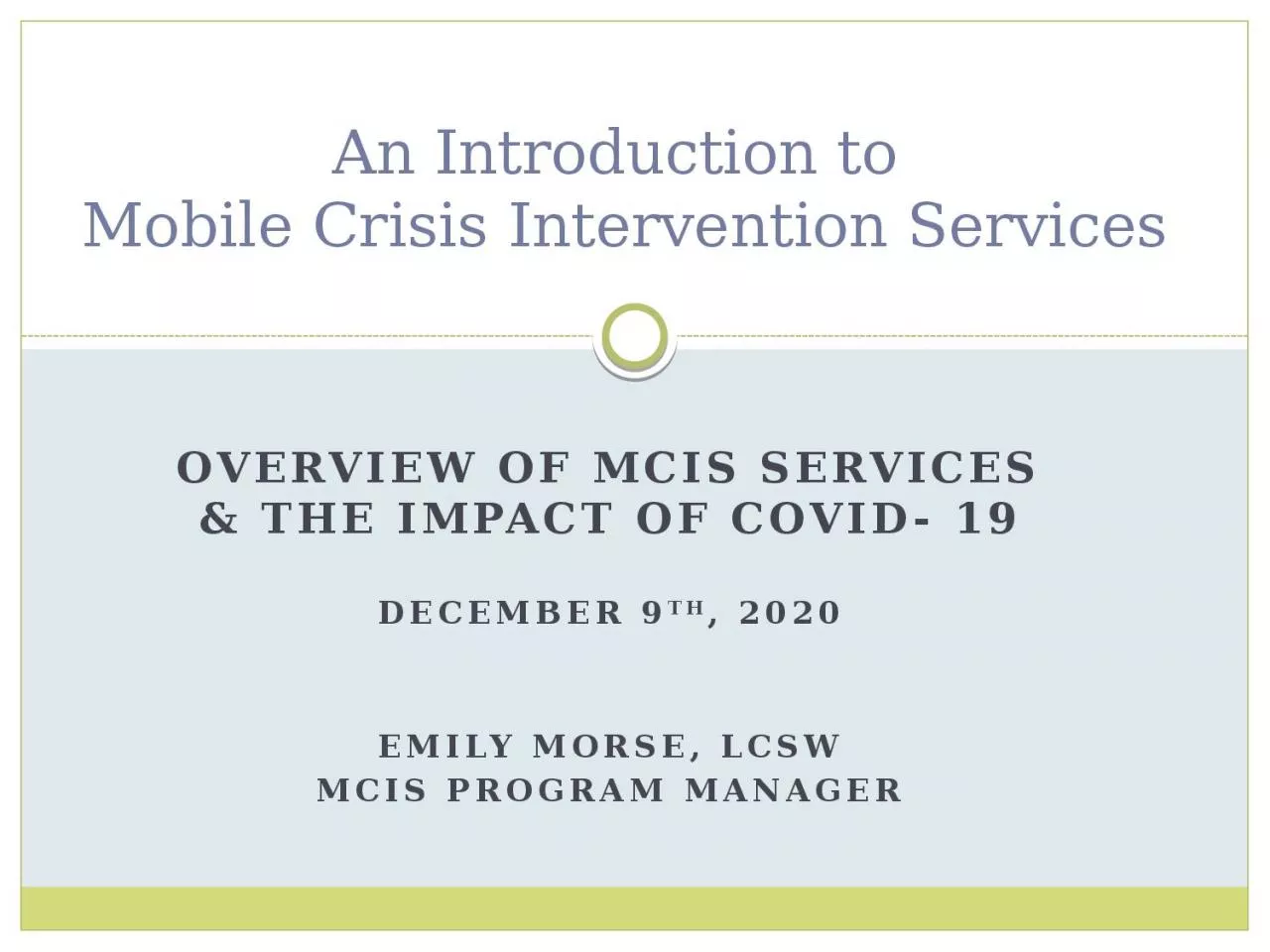

December 9 th 2020 Emily Morse LCSW MCIS Program Manager An Introduction to Mobile Crisis Intervention Services Mobile Crisis is a statewide voluntary crisis stabilizationhospital diversion program offered throughout the state of Connecticut ID: 934734
Download Presentation The PPT/PDF document "Overview of MCIS services & the Impa..." is the property of its rightful owner. Permission is granted to download and print the materials on this web site for personal, non-commercial use only, and to display it on your personal computer provided you do not modify the materials and that you retain all copyright notices contained in the materials. By downloading content from our website, you accept the terms of this agreement.
Slide1
Overview of MCIS services & the Impact of COVID- 19December 9th, 2020Emily Morse, LCSWMCIS Program Manager
An Introduction to
Mobile
Crisis Intervention Services
Slide2Mobile Crisis is a statewide, voluntary crisis stabilization/hospital diversion program offered throughout the state of Connecticut. To access Mobile Crisis services, dial 211, press 1, then press 1 again.
Alternate Phone Number for 211:
1-800-203-1234
What is Mobile Crisis?
Slide3Why call Mobile Crisis?To provide crisis intervention services for youth who are experiencing behavioral and/or mental health crises.To avoid youth having unnecessary assessments at the emergency department for behavioral health and mental health crises. Mobile Crisis can team with schools and other providers to address complex situations and make referrals for services in the community to prevent
future crises
.Mobile Crisis can bridge services until a youth is able to start long-term treatment when clinically appropriate.
Slide4Mobile Crisis at A Glance
Who does Mobile Crisis serve?
Mobile Crisis is
available for
any
youth 0-17
years
old (no minimum age) and 18 year olds who are still in high school/currently at the school in the state of CT who are experiencing a mental or behavioral health crisis.What constitutes a “crisis”? The crisis is defined by the caller; however, we frequently respond to calls for suicidality, homicidality, self-injurious behaviors, disruptive and combative behaviors, and symptoms of anxiety and depression.Where are youth assessed?: Typically about half of our calls come from schools and the other half come from families directly. We can assess youth anywhere in the community as long as we have permission to be there.When can families receive services?: MCIS is mobile from 6am-10pm Monday-Friday and 1pm-10pm Saturday-Sunday. A clinician is available for phone support 24 hours a day/ 365 days per year.What is the cost for services? There is no out of pocket cost to families for MCIS services, regardless of if the family has insurance. MCIS attempts to obtain insurance information to bill insurance; however, if the claim is denied or if there is a co-pay, the MCIS grant covers the cost.
Slide5During a MCIS assessment:After a MCIS assessment:
Gathering of background information from youth, guardians, and/or other involved parties.
Risk assessment is conducted.Safety plan is created.Treatment recommendations are made.
Follow-up telephone call to family.
Follow-up calls to current providers, school, etc.… (if releases were signed).
Referral to treatment when needed.
Bridging of care when appropriate (must maintain outpatient level of care).
Mobile Crisis Assessments & Follow Up
Slide6Other PertinentInformation:Mobile Crisis is a voluntary service. Families can decline services at any time regardless if they made the initial 211 call.
Assessments
can take place anywhere in the community; however, MCIS needs permission from homeowners/renters to conduct assessments in their homes. On average, a full assessment takes about two hours
.
Mobile Crisis is an unlimited use service.
Slide7MCIS Catchment Area by Provider
Slide8UCFS MCIS Program StructureSamantha Robinson, LCSWDirector of Clinical Community Based Programs
Emily Morse, LCSW
Program Manager
Jennifer Croce, LCSW Vernalisa
Walton-Bogel,
LCSW Lauren
Whitmore,
LCSW Crissy Waggoner Supervisor- Norwich Supervisor- Norwich Supervisor- Plainfield Project Assistant/Case Manager Clinicians/Liaisons FT Case Managers
Slide9Proactive Community Involvement
Members of Systems of Care collaboratives in both the NE and SE.
Participation in:
Community Coalition for Children (CCC)
Eastern
CT Suicide Advisory
Board
Juvenile Review BoardsClient Care Teams (CCT) and Child and Family Team (CFT) meetingsHuman Anti-Trafficking Response TeamProvide trainings and presentations on mental healthQPR (Question, Persuade, and Refer) trainings to local entities including fire departmentsSBIRT (Screen to Brief Intervention, Referral to Treatment)Presentations to local high school students on suicide awareness and prevention and mental healthClassroom de-escalation techniques Introduction to Child Trafficking in CT trainingParticipating in community events including health fairs, open houses, etc.…Provide support for schools and communities when there is an untimely death or community crisis.
Slide10Impact of COVID- 19 on MCIS Telehealth/telephonic assessmentsCall volume/referral sourceImpact on mobility and response
time
Acuity/Emergency Department referrals
Slide11Impact on Mobility at the Start of COVID- 19
Slide12Mobility- 90% BenchmarkResponse Time- 80% BenchmarkDCF Benchmarks
In SFY 2021 Q1, the mobility rate for the Eastern Region was 81.0% compared to 89.7% for SFY 2020 Q1
.
*Change to mobility in starting Q2 2021
In SFY 2021 Q1 62.5% of all mobile responses achieved the 45 minute mark, compared to 82.9% of mobile responses in SFY 2020 Q1. The median response time for SFY 2021 Q1 was 35 minutes.
Slide13Impact of COVID- 19 on Call Volume
Q1 2021 had a 27.7
% decrease when compared to SFY 2020 Q1.
Slide14Referral Sources During Q1 2021Referral Source:73.4% - Self/Family8.2% - Schools
8.2% - Other Community Provider Agency
4.3% - Psychiatric Hospital 2% - Foster Parent
2% - Physician- 2%
1% - Emergency Department- 1%
.5% - Other Program within Agency
.5% - Police- .5%
Slide15Referrals to the ED: Q4 2019-Q2 2021
# of Referrals
Number of ED Referrals Per Quarter
Percentage of Total Calls Referred to ED Per Quarter
Slide16Outcome of ED Referrals
Was the youth admitted inpatient?
Slide17Any questions?
Emily Morse, LCSW- 860-822-4796 / emorse@ucfs.org